What is Cymatics
By John Stuart and Analiese Shandra Reid
Introduction
Cymatics is the study of sound and vibration made visible, typically on the surface of a plate, diaphragm or membrane. Direct ocular viewing of vibrations involves exciting inorganic matter such as particulate matter, pastes (both magnetic and non magnetic) and liquids under the influence of sound, although recent research has extended the range of media to include organic matter 1 and the range of viewing has been extended to include the light microscope.2
The generic term for this field of science is the study of ‘modal phenomena, named ‘Cymatics’ by Hans Jenny, a Swiss medical doctor and a pioneer in this field. The word ‘Cymatics’ derives from the Greek ‘kuma’ meaning ‘billow’ or ‘wave,’ to describe the periodic effects that sound and vibration has on matter.
The apparatus employed can be simple, such as a Chladni Plate (a flat brass plate excited by a violin bow) or advanced such as the CymaScope, a laboratory instrument co-invented by English acoustics engineer, John Stuart Reid and American design engineer, Erik Larson, that makes visible the inherent geometries within sound and music.
Cymatics History
The provenance of Cymatics can be traced back at least 1000 years to African tribes who used the taut skin of drums sprinkled with small grains to divine future events. 3 The drum is one of oldest known musical instruments 4 and the effects of sand on a vibrating drumhead have probably been known for millennia.
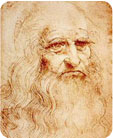 Leonardo Da Vinci (b 1452 d 1519) noticed that vibrating a wooden table on which dust lay created various shapes.
Leonardo Da Vinci (b 1452 d 1519) noticed that vibrating a wooden table on which dust lay created various shapes.
‘I say then that when a table is struck in different places the dust that is upon it is reduced to various shapes of mounds and tiny hillocks. The dust descends from the hypotenuse of these hillocks, enters beneath their base and raises itself again around the axis of the point of the hillock.’ 5
 Galileo Galilei (b 1564 d 1642) described scraping a brass plate with a chisel and noticed a ‘long row of fine streaks, parallel and equidistant from one another,’ 6 presumably caused by the brass filings dancing on the surface of the plate and finding safe haven in a series of parallel nodal striations.
Galileo Galilei (b 1564 d 1642) described scraping a brass plate with a chisel and noticed a ‘long row of fine streaks, parallel and equidistant from one another,’ 6 presumably caused by the brass filings dancing on the surface of the plate and finding safe haven in a series of parallel nodal striations.
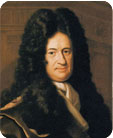 Robert Hooke (b 1635 d 1703) was an English scientist of Oxford University who made contributions to many scientific fields including mathematics, optics, mechanics and astronomy. Hook devised a simple apparatus in 1680 consisting of a glass plate covered with flour that he ‘played’ with a violin bow. It is not known whether Hooke had access to the notebooks of Leonardo da Vinci or Galileo Galilei or if he devised the apparatus independently.
Robert Hooke (b 1635 d 1703) was an English scientist of Oxford University who made contributions to many scientific fields including mathematics, optics, mechanics and astronomy. Hook devised a simple apparatus in 1680 consisting of a glass plate covered with flour that he ‘played’ with a violin bow. It is not known whether Hooke had access to the notebooks of Leonardo da Vinci or Galileo Galilei or if he devised the apparatus independently.
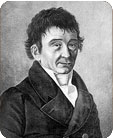 Ernst Chladni (1756-1827) German musician and scientist, sometimes known as ‘the father of acoustics,’ almost certainly had access to Hooke’s work but it is Chladni who history has chosen to acknowledge for his major study of this class of phenomena.
Ernst Chladni (1756-1827) German musician and scientist, sometimes known as ‘the father of acoustics,’ almost certainly had access to Hooke’s work but it is Chladni who history has chosen to acknowledge for his major study of this class of phenomena.
He used a sand-strewn brass plate, excited by a violin bow; since brass is a highly resonant material he found that a large number of archetypal geometric patterns could be created, depending on where on the edge of the plate the bow was drawn. These patterns are now known as ‘Chladni Figures.’
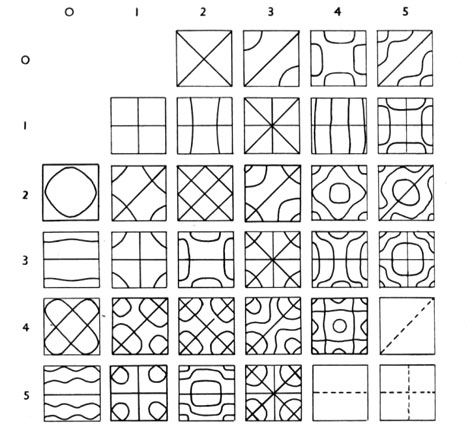
Chladni demonstrated this seemingly magical phenomenon all over Europe and even had an audience with Napoleon. The French leader was so impressed he sponsored a competition with The French Academy of Sciences to acquire a mathematical explanation of the sand patterns. Sophie Germain (1776-1831), a young French woman, won Napoleon’s 3,000 Franc prize in 1816. She wrote a mathematical explanation involving wave-like functions to describe how sound created the geometric patterns. The inference was that sound ‘waves’ * were responsible for creating areas of vibration and areas of stillness on the surface of the plate. It was believed that the crest of the sound ‘wave’s caused certain areas of the plate to vibrate while the corresponding troughs caused other areas to remain still. The sand gathered in the still areas. His pioneering book ‘Entdeckungen ber die Theorie des Klanges’ 7 (‘Discoveries in the Theory of Sound’) was published in 1787 and is still considered an important milestone in launching the science of acoustics.
*The term ‘wave’ has historically been used to describe sound even though it is a misnomer since sound does not, in fact, travel in waves. Sound propagates spherically or in beams, depending upon frequency. For example, at frequencies audible to humans, 20 Hertz to 20,000 Hertz, the sonic envelope is almost perfectly spherical in its form whereas at frequencies audible to bats and dolphins, above 100,000 Hertz, sound propagates in searchlight-like beams, the beam angle being dependant on frequency. Higher frequencies cause a reduction in beam angle.
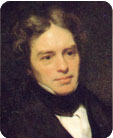 Michael Faraday, (b 1791 d 1867) the English chemist and physicist, studied what he termed ‘crispations’ between February and July 1831. His diary records many experiments in which he studied the effects of vibration on water, oil and fine grains. Faraday was fascinated by these phenomena and always sensible of good demonstrations to his audiences at the Royal Institution.
Michael Faraday, (b 1791 d 1867) the English chemist and physicist, studied what he termed ‘crispations’ between February and July 1831. His diary records many experiments in which he studied the effects of vibration on water, oil and fine grains. Faraday was fascinated by these phenomena and always sensible of good demonstrations to his audiences at the Royal Institution.
He wrote: ‌On putting a candle exactly below this plate and holding a screen of tracing paper an inch above it, the picture given was beautiful. Each heap [of sand] gave a ‘star’ of light at its focus which twinkled, i.e. appeared and disappeared with the heap continually as it rose and fell. At the corners a fainter light appeared, and then as the screen was nearer or farther lines of light in 2 or even 4 directions appeared (constant). This was exceedingly beautiful and easily rendered visible to a large audience.â€Â_ 8
Faraday did not identify any potential applications for crispations and as far as is known never reopened his investigations in this field.
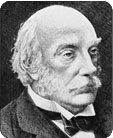 Lord Rayleigh, John William Strutt, 3rd Baron Rayleigh, (b 1842 d 1919) was an English physicist and second Cavendish Professor of Physics at Cambridge University following James Clerk Maxwell. Rayleigh earned the Nobel Prize for Physics in 1904, along with William Ramsay, for the discovery of the element argon. He also discovered surface waves in seismology, now known as Rayleigh waves.
Lord Rayleigh, John William Strutt, 3rd Baron Rayleigh, (b 1842 d 1919) was an English physicist and second Cavendish Professor of Physics at Cambridge University following James Clerk Maxwell. Rayleigh earned the Nobel Prize for Physics in 1904, along with William Ramsay, for the discovery of the element argon. He also discovered surface waves in seismology, now known as Rayleigh waves.
His major treatise, ‘Theory of Sound,’ 9 in two volumes, includes a chapter on the ‘Vibrations of Plates’ and is still considered an important work. In it he explored modal phenomena in depth, now part of the emergent science of cymatics.
Margaret Watts-Hughes (b? d 1907) a Welsh woman, experimented with a device she invented in 1885 and named the ‘Eidophone.’ Her invention consisted of a wooden resonating chamber with an open end across which was stretched a rubber membrane, strewn with sand and other media. By singing into a tube that interfaced with the resonating chamber she was able to create ‘voice figures.’ It seems likely that she had been inspired by the work of Michael Faraday since she uses the term ‘crispations’ when discussing the patterns she observed. Like Faraday she was much taken with the beauty of the forms and in an article now accessible in the Cornell University Library wrote: ‘…I have gone on singing into shape these peculiar forms, and stepping out of doors, have seen their parallels in the flowers, ferns, and trees around me; and again, as I have watched the little heaps in the formation of the floral figures gather themselves up and then shoot out their petals, just as a flower springs from the swollen bud’ the hope has come to me that these humble experiments may afford some suggestions in regard to nature’s production of her own beautiful forms.’ She was able to take impressions of the voice figures by applying a coated glass plate onto the moist forms although it is not known what form the coating took.

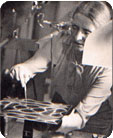 Mary Desiree Waller (b d 1959) was the daughter of a famous English physiologist, August D. Waller. Mary Waller became Professor of Physics at the Royal Free Hospital Medical School in London. She became fascinated by Chladni’s work and recreated all the forms he discovered, taking his work to a higher level.
Mary Desiree Waller (b d 1959) was the daughter of a famous English physiologist, August D. Waller. Mary Waller became Professor of Physics at the Royal Free Hospital Medical School in London. She became fascinated by Chladni’s work and recreated all the forms he discovered, taking his work to a higher level.
Her book ‘Chladni Figures, a Study in Symmetry’ 11 was published posthumously in 1961 and includes details of her novel method of exciting plates employing solid carbon dioxide chips. She approached the subject of Chladni Figures with scientific rigor and her work represents a rich resource for students of this branch of acoustics, including some of the mathematical equations that describe the phenomena.
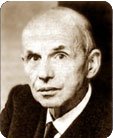 Hans Jenny (b 1904 d 1972) was a Swiss medical doctor and scientist who studied visual sound intensively. Jenny published his first volume Kymatic, in 1967 12 and his second in 1972,13 the year he died. Jenny coined the word Kymatik, (‘cymatic’ in English) from the Greek ‘Kuma’ meaning ‘billow’ or ‘wave,’ to describe the periodic effects that sound and vibration has on matter.
Hans Jenny (b 1904 d 1972) was a Swiss medical doctor and scientist who studied visual sound intensively. Jenny published his first volume Kymatic, in 1967 12 and his second in 1972,13 the year he died. Jenny coined the word Kymatik, (‘cymatic’ in English) from the Greek ‘Kuma’ meaning ‘billow’ or ‘wave,’ to describe the periodic effects that sound and vibration has on matter.
His two volumes are rich sources of cymatic imagery, which he observed and described in great detail, although leaving scientific and mathematical explanations to scientists who would come after him.
Jenny invented the ‘Tonoscope’ a device similar to Margaret Watts-Hughes’ Eidophone but including an electro-mechanical transducer to excite the membrane; he was also the first to suggest that such a device may one day assist deaf individuals to acquire speech.
Jenny also excited steel plates using piezo crystal elements driven by an electronic oscillator, devices not available to Margaret Watts-Hughes and other acoustic pioneers of the past. The piezo crystal transducers were able to excite the plates in a wide range of frequencies, including high audible frequencies, resulting in the formation of complex sand-pattern forms.
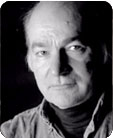 Alexander Lauterwasser, (b ?) is a German researcher and photographer basing his work on that of Hans Jenny. Lauterwasser is interested in the phenomenology and typography of the shapes formed by the effects of sound on water and in comparing the shapes with those that occur in nature, such as in the morphogenesis of creatures and the archetypal forms of inanimate matter. His 2002 book Wasser Klang Bilder (Water Sound Images)14 set new standards in cymatic imagery.
Alexander Lauterwasser, (b ?) is a German researcher and photographer basing his work on that of Hans Jenny. Lauterwasser is interested in the phenomenology and typography of the shapes formed by the effects of sound on water and in comparing the shapes with those that occur in nature, such as in the morphogenesis of creatures and the archetypal forms of inanimate matter. His 2002 book Wasser Klang Bilder (Water Sound Images)14 set new standards in cymatic imagery.
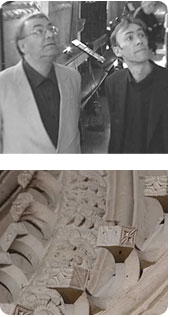 Thomas J. Mitchell (b 1938) is a Scottish musician who studied the ornately carved ceiling of Rosslyn Chapel for 27 years. Rosslyn Chapel, near Edinburgh, famous for its lavish carvings and its association with the Knights Templar, also contained a mystery in the form of four sections of arches containing cymatic-like designs carved into the faces of 215 rectilinear cubes.
Thomas J. Mitchell (b 1938) is a Scottish musician who studied the ornately carved ceiling of Rosslyn Chapel for 27 years. Rosslyn Chapel, near Edinburgh, famous for its lavish carvings and its association with the Knights Templar, also contained a mystery in the form of four sections of arches containing cymatic-like designs carved into the faces of 215 rectilinear cubes.
Mitchell discovered that the patterns related to musical notes, to be read in a specific order, postulating that the builders of the chapel had access to Chladni-style plate and bow technology and deliberately encoded the melody into the cubes.
His son, Stuart Mitchell, orchestrated the music thus revealed, and named it ‘The Rosslyn Motet.’ It was played on traditional medieval musical instruments in the chapel in September 2006. Mitchell’ book ‘Rosslyn Chapel ‘ The Music of the Cubes’16 was also published in 2006.
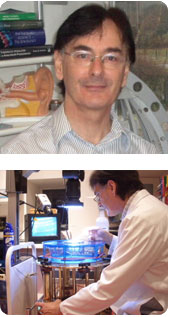 John Stuart Reid (b 1948) is an acoustics engineer who carried out cymatics research in the King’s Chamber of the Great Pyramid of Egypt in 1997. Reid published his research results in Egyptian Sonics 17 containing photographs of the cymatic patterns that formed on a PVC membrane he stretched over the sarcophagus. The experiment was designed to study the resonant behaviour of the granite from which the sarcophagus is fashioned. Since many of the images strongly resemble ancient Egyptian hieroglyphs Reid postulated that the inherent resonances of granite, when radiated as a complex sound field during crafting of the stone, might have influenced the development of hieroglyphic writing. Reid subsequently began experimenting with instrumentation that would enable an accurate visual equivalent of sound to be created from any audible sound, resulting in the invention of the CymaScope, a patented scientific instrument. Reid worked with American design engineer, Erik Larson to engineer the instrument to Pythagorean proportions.
John Stuart Reid (b 1948) is an acoustics engineer who carried out cymatics research in the King’s Chamber of the Great Pyramid of Egypt in 1997. Reid published his research results in Egyptian Sonics 17 containing photographs of the cymatic patterns that formed on a PVC membrane he stretched over the sarcophagus. The experiment was designed to study the resonant behaviour of the granite from which the sarcophagus is fashioned. Since many of the images strongly resemble ancient Egyptian hieroglyphs Reid postulated that the inherent resonances of granite, when radiated as a complex sound field during crafting of the stone, might have influenced the development of hieroglyphic writing. Reid subsequently began experimenting with instrumentation that would enable an accurate visual equivalent of sound to be created from any audible sound, resulting in the invention of the CymaScope, a patented scientific instrument. Reid worked with American design engineer, Erik Larson to engineer the instrument to Pythagorean proportions.
Reid recognized that the wave model of sound is incomplete because it does not characterize the spherical space-form of audible sound. CymaGlyph images, created on the CymaScope, are considered to be analogs of sound and music since the geometries they contain represent mathematical correlates of the musical pitches that caused the pattern to form on the instrument’s membrane.
One of the many potential applications being explored for the CymaScope is the decipherment of dolphin language in collaboration with SpeakDolphin.com, a Florida-based organization formed for this purpose.
Notes:
1,2. John Stuart Reid
3. Encyclopedia of Religion Volume 4. Eliade, Mircea (Editor)
Mc Millan Free Press.
4. The History of Musical Instruments. Sachs, Curt. W.W. Norton & Co. New York.
5. Notebooks of Leonardo da Vinci. Mac Curdy, E. 1938. Jonathan Cape, London.
6. Traite de Physique. Biot, J.B. 1816. Deterville, Paris.
7. Entdeckungen uber die Theory des Klanges. (‘Discoveries in the Theory of Sound’) Chladni, Ernst F. 1787.
8. Faraday, the Life. Hamilton, James. HarperCollins.
9. Theory of Sound (Two Volumes) Strutt, John W. (Lord Rayleigh) 1877 and 1878
10. The Eidophone Voice Figures. Borderland Sciences Research Foundation.
11. Chladni Figures, A Study in Symmetry. Waller, Mary D. 1961 G. Bell & Sons.
12. Cymatics (Volume 1) Jenny, Hans. 1967, Basilius Press.
13. Cymatics (Volume 2) Jenny, Hans. 1974, Basilius Press.
14. Wasser Klang Bilder. Lauterwasser, A., A T Verlag, Switzerland.
English Edition: Water Sound Images. MACROmedia Publishing.
15. Water Klank Beelden, Boerman, R. Ankh-Hermes bv.
16. Rosslyn Chapel, The Music of the Cubes. Mitchell, Thomas A. Diversions.
17. Egyptian Sonics. Reid, John S. Sonic Age.
Content courtesy of John Stuart and Analiese Shandra Reid
Copyright (c) 2011. All Rights Reserved.
http://www.cymascope.com









